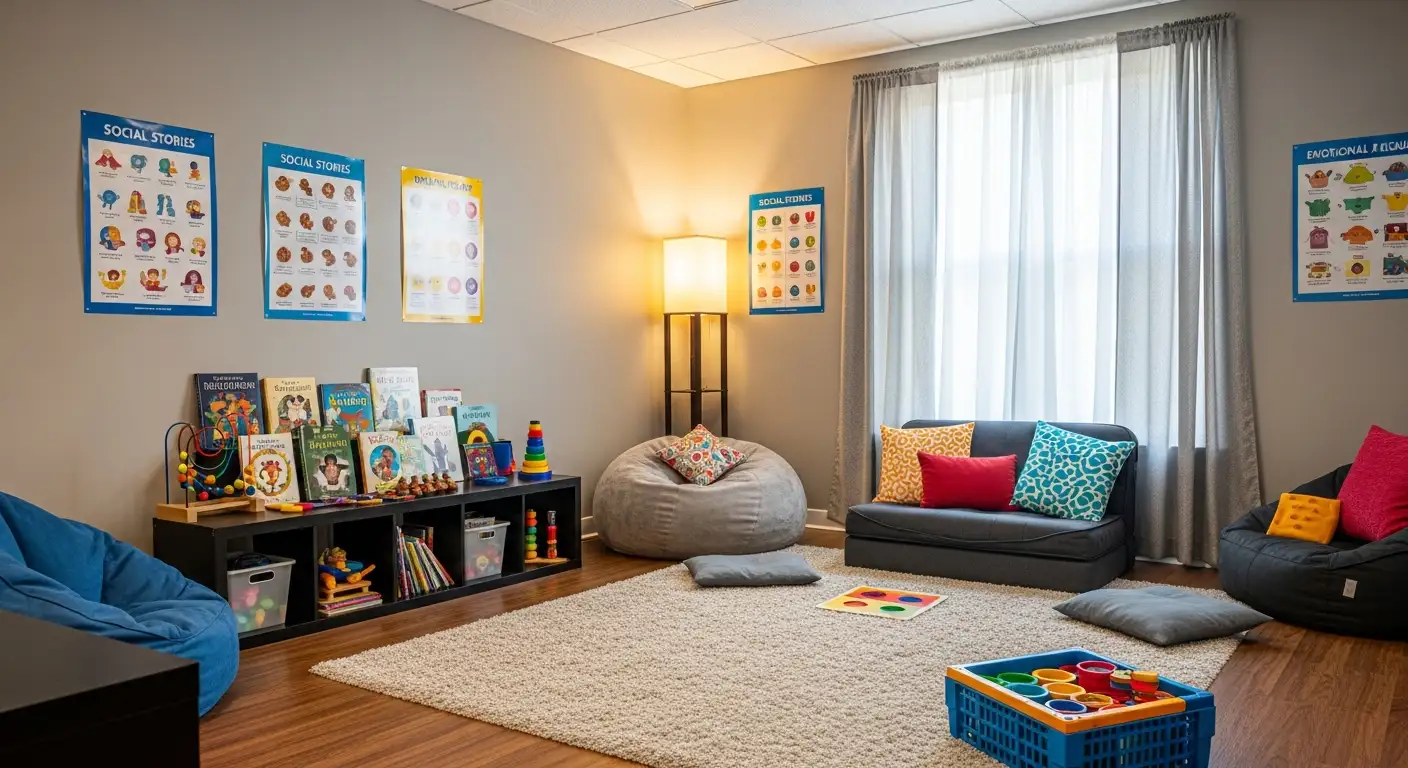How to Build Self-Regulation Skills with ABA Therapy
Unlocking Potential: Enhancing Self-Regulation in Autism Through ABA Therapy

Understanding the Role of ABA Therapy in Self-Regulation
Applied Behavior Analysis (ABA) therapy is a cornerstone in autism intervention, transforming lives by enhancing critical skills like self-regulation and impulse control. Rooted in behavioral science, this therapy method breaks down complex behaviors into achievable steps, empowering children with autism spectrum disorder (ASD) to manage their responses more effectively. This article explores how ABA therapy builds these self-regulation skills, the science behind its approach, and the collaborative efforts that maximize its success.
What is ABA Therapy and Its Role in Autism Intervention?

What is Applied Behavior Analysis (ABA) therapy, and how does it help individuals with autism?
Applied Behavior Analysis (ABA) therapy is a science-based approach rooted in behavioral principles designed to support children with autism. It focuses on understanding and improving specific behaviors by breaking them down into manageable steps. Through individualized programs, ABA helps children develop crucial skills like communication, social interaction, and self-regulation.
Scientific principles behind ABA
ABA relies on solid scientific principles such as consistent reinforcement, task analysis, and data-driven adjustments to teaching strategies. Techniques like discrete trial training (DTT), pivotal response training (PRT), and differential reinforcement of alternative behaviors (DRA) are common methods used to encourage positive behaviors and reduce challenges. ABA emphasizes ongoing assessment and variation to meet each child's unique learning needs.
Areas ABA addresses in autism
ABA therapy targets several core areas affected by autism spectrum disorder, including social communication, emotional and impulse regulation, and daily living skills. For example, impulse control—often difficult for children with autism due to sensory processing and executive functioning differences—is taught through step-by-step guidance and environmental supports.
Benefits of early ABA intervention
Starting ABA therapy early, ideally before the age of five, can dramatically improve outcomes. Early engagement enhances social communication, emotional regulation, and impulse control when children's brains are most adaptable. This early intervention increases the chances of children generalizing learned skills across settings.
Evidence supporting ABA effectiveness
Numerous studies and clinical experiences support ABA as an effective treatment for autism. It improves communication, reduces challenging behaviors, and promotes independence. Collaboration with families and educators ensures consistent skill reinforcement in different environments, maximizing the therapy's benefit.
By combining scientific rigor with personalized interventions, ABA therapy remains a leading approach for fostering growth and self-regulation in children with autism.
The Science of Self-Regulation and Impulse Control Challenges in ASD

What is Impulse Control?
Impulse control refers to the ability to pause, think, and choose appropriate responses rather than reacting on a whim. It involves managing immediate urges and exercising thoughtful decision-making.
Why is Impulse Control Difficult for Children with ASD?
Children with autism spectrum disorder (ASD) often face challenges with impulse control due to difficulties in executive functioning. This includes problems with planning, flexible thinking, and self-monitoring.
How Do Sensory Processing Differences Affect Impulse Control?
Many children with ASD experience sensory processing differences that can trigger impulsive reactions. For example, they might respond abruptly to certain noises, textures, or visual stimuli, making it harder to regulate their behavior.
How Do Self-Regulation Deficits Impact Behavior?
When self-regulation skills are underdeveloped, children may react quickly and spontaneously, sometimes leading to difficulties in social interactions and daily routines. These behaviors often stem from challenges with managing sensory input and executive function.
Understanding these barriers helps inform targeted interventions like Applied Behavior Analysis (ABA), which breaks down impulses into manageable steps and uses evidence-based strategies to improve self-regulation and impulse control in children with ASD.
Key ABA Techniques to Develop Self-Regulation Skills
How are task analysis and discrete trial training (DTT) used in ABA for self-regulation?
Task analysis breaks down complex skills, like impulse control, into smaller, manageable steps. Discrete trial training (DTT) then systematically teaches each step through repeated trials with clear instructions and immediate feedback. This structured approach helps children understand and practice self-regulation gradually, building confidence and mastery.
What role do positive reinforcement and differential reinforcement of alternative behaviors (DRA) play?
Positive reinforcement rewards desired behaviors, encouraging children to repeat them. Differential reinforcement of alternative behaviors (DRA) strengthens appropriate behaviors by providing rewards when the child chooses more constructive responses instead of acting impulsively. Together, these strategies promote impulse control through consistent and motivating incentives.
How does pivotal response training (PRT) support self-regulation?
Pivotal response training (PRT) targets pivotal areas like motivation and self-initiation. By making learning natural and engaging, PRT encourages children to take control over their behaviors. This approach improves impulse control by helping learners respond thoughtfully in everyday situations rather than reacting impulsively.
What are self-management strategies and visual supports, and how do they help?
Self-management involves teaching children to monitor and regulate their own behavior using specific goals, behavior logs, and rewards. Visual supports like charts or cue cards guide them through the steps and track progress. This empowers children with ASD to independently control impulses and develop lasting self-regulation skills.
How do functional behavior assessments (FBA) and behavior intervention plans (BIPs) contribute?
FBAs identify triggers and underlying reasons for impulsive behaviors by analyzing patterns. Using this information, ABA practitioners design individualized behavior intervention plans (BIPs) tailored to each child's needs. These plans include strategies to reduce impulsivity and teach alternative, more effective responses.
These ABA techniques collectively build a comprehensive framework that supports children with autism in developing essential self-regulation skills for improved daily functioning and social interactions.
Customizing ABA Therapy Programs for Individual Needs

How is an ABA therapy program customized to meet the needs of an individual with autism?
ABA therapy programs begin with comprehensive assessments such as direct observations, standardized testing, and interviews with caregivers. These evaluations help identify each child's unique strengths, challenges, and specific behavioral targets.
Using this information, a behavior analyst designs a personalized intervention plan that addresses areas like communication, social skills, self-care, and academic skills. Tailored ABA techniques—such as positive reinforcement and functional behavior assessments—ensure the program addresses the individual's particular needs effectively.
Goals are carefully set to be specific, measurable, and achievable. The intervention strategies are incorporated into the child's natural routines and individual preferences, which helps improve engagement and learning.
Ongoing data collection allows therapists to closely monitor progress, making adjustments when necessary to keep the program dynamic and responsive to the child's growth.
Family members and educators play a critical role by reinforcing skills consistently across home, school, and community environments. This collaboration encourages the generalization of learned behaviors, leading to improved independence and better overall development.
The Role of Sensory Integration and Environmental Modifications

Sensory Triggers of Impulsive Behavior in ASD
Children with autism spectrum disorder (ASD) often experience sensory processing differences that can provoke impulsive behaviors. For example, overwhelming noises or uncomfortable textures may cause a sensory overload, making it harder for a child to pause and regulate their reactions. These sensory triggers are a significant factor contributing to challenges in impulse control.
Sensory Integration Therapy Approaches
To address these sensory-related challenges, sensory integration therapy is frequently incorporated alongside Applied Behavior Analysis (ABA). This therapy helps children process and respond to sensory input more effectively by exposing them to sensory experiences in a structured and supportive way. Sensory integration therapy can reduce sensory overloads, helping children stay calmer and more in control of their behaviors.
Environmental Modifications Supporting Impulse Control
Adjusting a child's environment is another practical strategy to support impulse control. Modifications may include minimizing loud or unpredictable noises, providing comfortable and calming sensory tools, or arranging spaces to reduce overwhelming stimuli. These changes create a more manageable setting that encourages self-regulation and reduces impulsivity.
Addressing Sensory Processing Differences as Part of ABA
Within an ABA program, addressing sensory processing differences is essential. Behavioral interventions are tailored to include sensory-based strategies and environmental adaptations. By understanding each child’s unique sensory needs, ABA practitioners design comprehensive plans that promote impulse control through both behavioral techniques and sensory accommodations. This holistic approach supports the child's ability to regulate impulses effectively across different situations.
Empowering Learners Through Self-Management and Independence
What is Self-Management in ABA?
Self-management in ABA therapy teaches children with autism spectrum disorder (ASD) to regulate their own behavior by applying ABA principles independently. This approach equips learners with skills to monitor, evaluate, and adjust their impulses, fostering greater autonomy and control.
What Are the Steps in Creating a Self-Management Plan?
A self-management plan typically starts with setting a clear, achievable goal related to impulse control or another target behavior. The environment may be modified to support success, such as providing visual reminders or reducing distractions. The learner then keeps a behavior log to track their actions, and positive reinforcement is used when goals are accomplished.
How Are Learners Involved in Goal Setting and Behavior Logging?
Learners actively participate by selecting or understanding their goals and recording their own behaviors and progress. This involvement promotes engagement and ownership of their learning process. It also helps develop self-awareness and accountability.
How Does Gradual Fading of Therapist Support Work?
Initially, the ABA practitioner guides the learner closely, instructing and prompting as needed. Over time, support is reduced so the learner can independently manage their behavior. This fading process ensures that new skills become firmly established and that confidence grows.
How Does This Promote Learner Independence and Autonomy?
By actively implementing strategies, monitoring behavior, and receiving positive feedback, learners gain confidence in managing their impulses. This empowerment leads to improved self-regulation skills, better social interactions, and enhanced daily functioning across settings without constant external prompts.
The Collaborative Approach to Sustaining Self-Regulation Skills

How do therapists, families, and educators collaborate in ABA therapy?
ABA therapy is most effective when delivered through a collaborative team effort. Therapists—such as Board Certified Behavior Analysts (BCBAs) and Registered Behavior Technicians (RBTs)—work closely with families and educators to create consistent learning experiences. This collaboration ensures intervention strategies for impulse control and self-regulation are reinforced throughout daily routines, school, and home environments.
Why is consistent reinforcement across environments important?
Children with ASD benefit from repetition and predictability. Consistent reinforcement helps the child practice self-regulation skills such as pausing to think before acting, in varied settings. When families and educators use the same teaching methods and encourage the same behaviors, children generalize these skills, meaning they apply them beyond therapy sessions to real-life situations.
How does generalization improve impulse control?
Generalization allows children to transfer skills learned in structured therapy to social interactions, classroom activities, and daily functioning. ABA strategies focus on teaching impulse control in manageable steps and emphasizing practice across contexts. This promotes better peer interactions and emotional regulation, empowering children to navigate everyday challenges more independently.
What benefits does teamwork bring to intervention success?
Teamwork brings multiple perspectives and expertise together, enabling personalized planning that considers the child’s sensory needs, triggers, and strengths. With shared goals and data-driven feedback, the team adjusts plans to maximize progress. Families gain confidence through ongoing support, while educators integrate reinforcement into academic settings, creating a unified support system for the child.
How does collaboration support daily functioning and peer interactions?
By aligning efforts, the team helps children develop critical self-management skills, fostering autonomy and positive social behavior. Children learn to monitor their responses, use visual supports, and manage impulses effectively. The improved self-regulation skills lead to enhanced participation in school and social environments, increasing opportunities for meaningful peer relationships and smoother daily routines.
Who provides ABA therapy services, and what qualifications do professionals typically have?
ABA therapy providers comprise a team of highly trained professionals including BCBAs, Board Certified Assistant Behavior Analysts (BCaBAs), and Registered Behavior Technicians (RBTs). BCBAs hold graduate degrees and state licensure, overseeing individualized treatment plans. BCaBAs support BCBAs through supervision and assessments, while RBTs implement therapy and collect data under guidance. All team members possess specialized training in behavior analysis principles and evidence-based interventions, ensuring effective support for children with autism to develop vital self-regulation and social skills.
Building Lifelong Self-Regulation Skills with ABA Therapy
ABA therapy offers a well-researched, systematic approach to building self-regulation skills for children with autism. By addressing impulse control through customized, data-driven interventions and empowering learners with self-management strategies, ABA paves the way for greater independence and social success. When paired with sensory integration techniques and supported by collaborative teams of professionals and families, these self-regulation skills extend beyond therapy settings to everyday life, promoting lasting improvements in emotional control and peer interactions. Investment in ABA therapy reveals profound potential to transform challenges into strengths, unlocking new pathways for children with autism to thrive.
References
- ABA Therapy for Impulse Control Strategies
- What is Self-Management in ABA Therapy?
- Applied Behavior Analysis (ABA)
- The effectiveness of applied behavior analysis program ...
- 6 Benefits of ABA Therapy for Children with Autism
- Applied Behavior Analysis (ABA)
- What is an ABA Therapist?
- Types Of ABA Therapy Jobs And Their Degree Requirements
- Applied Behavior Analysis (ABA)
- Understanding Your Child's ABA Therapy Providers






